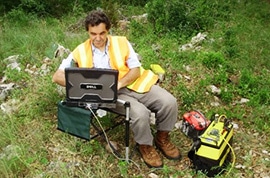It was a few years ago, when an engineering client from Texas called for a geophysical proposal for a newly constructed shopping mall. He said that three buildings at the mall, let’s say X, Y, and Z, were experiencing floor deformation due to subsurface water flow, and that he would like to use geophysics to determine the cause of the problem. But his client, a real-estate company, was not familiar with geophysical techniques, thus he wanted to know if we could offer to his client 5 top reasons to use geophysical methods instead of traditional methods, such as trenching, boring and installing piezometers.
We formulated the five top reasons why we believe geophysical methods are required to explore the area at buildings X, Y, and Z at the Mall Shopping Center. The reasons are as follows:
1. Geophysical methods allow for continuous scanning of the subsurface soils. Because of the ability to scan continuously, these methods are able to locate relatively small or narrow areas where water may be transported into the foundation areas of the buildings. In addition, they provide information on the types of soil present, the thickness of fill bodies, and the presence of voids. To accomplish the same task with piezometers, a large number of piezometers would be required because piezometers only allow observations of conditions at discrete points. Test trenches may also be used to provide the same information. However, trenches are able to observe soil only along a single profile.
2. Geophysical methods are non-invasive and won’t significantly impede traffic behind the buildings or impact store operations. Because these methods are non-invasive, they are very quiet and require only two people to conduct the surveys. Test trenches require significant excavation, requiring that some of the drive area behind the buildings be obstructed during excavation. Additional areas will be required to stockpile excavated soils for later backfilling the trench. Trenching also runs a risk of damage to underground utilities. Drilling soil borings or excavating trenches will require heavy equipment and often may be quite loud. In addition, drilling and trenching require the use of several people for safe and effective operation of the equipment.
3. Geophysical methods locate utility lines so that there is less risk of damage to the utilities during any subsequent excavations, such as those required to install French drains.
4. Geophysical methods allow for short field operation and data reduction times. Geophysical fieldwork necessary to scan the areas behind the buildings would take three days. For this project, processing geophysical data and preparing a report would take six days. Depending on crew and equipment availability, weather condition, tenant issues, and other factors, large numbers of borings or trenching may take several days longer.
5. Lastly, geophysical survey methods make it possible to significantly reduce the cost of exploring the subsurface soils over large areas such as the area located behind buildings X, Y, and Z. This is possible because of the relatively short duration of geophysical field work, significantly fewer required borings and piezometers for confirmation of the geophysical data, and no required trenching. The potential returns in usable data are large compared with the cost because these methods allow for continuous scanning of the area, which greatly reduces the risk of missing small features easily missed by the other exploration methods.
Mustafa Saribudak, Ph.D., P.G., is Principal Geophysicist-Geologist at Environmental Geophysics Associates, based in Austin, Texas.





